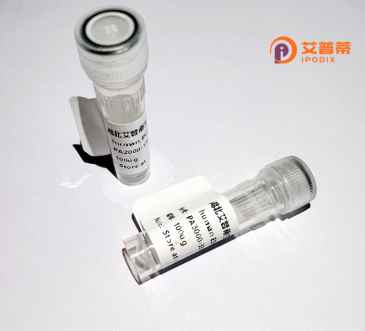
| 纯度 | >90%SDS-PAGE. |
| 种属 | Human |
| 靶点 | C9orf173 |
| Uniprot No | Q8N7X2 |
| 内毒素 | < 0.01EU/μg |
| 表达宿主 | E.coli |
| 表达区间 | 1-386aa |
| 氨基酸序列 | MMNSDQKAVKFLANFYINGGKHWTHGHLRQTQPEPTQPKASVLLLGPEPGMAWDETQPPKMKEIPVGLRLQTGTPQESLPTYTQTLRELLLEQRPLITADLEVPSPTRYQVPSPSVRESSPHPHYSIGCKHQGREGGGRRAWQTLWFQSESPFTQKADFDQEQKWPSPAHYQLLSRPAFPAFSFRGCHSASKTPEGHTHLGLPGARGLGLRVQPQSLLQASLQAPGKRCPGPNTYNILPGSRLQSPRSPAFSMSRSPAFTSWLSTSFSFGSPNPWPSRLPRGGLQLTLPFGAWRGHPGCTQTQAPRHRPLLHALEPAGHNLLGPATEWNHGLPRGFPRPPLGLGAPAWPSDPLGTPMHPSGWPTLLWAVDKAGPAWIPHLPISPLH |
| 分子量 | 42.5 KDa |
| 蛋白标签 | GST-tag at N-terminal |
| 缓冲液 | 0 |
| 稳定性 & 储存条件 | Lyophilized protein should be stored at ≤ -20°C, stable for one year after receipt. Reconstituted protein solution can be stored at 2-8°C for 2-7 days. Aliquots of reconstituted samples are stable at ≤ -20°C for 3 months. |
| 复溶 | Always centrifuge tubes before opening.Do not mix by vortex or pipetting. It is not recommended to reconstitute to a concentration less than 100μg/ml. Dissolve the lyophilized protein in distilled water. Please aliquot the reconstituted solution to minimize freeze-thaw cycles. |
以下是关于重组人未表征蛋白 **C9orf173** 的假设性参考文献(供参考,实际文献需通过数据库验证):
---
1. **文献名称**: *"Bioinformatics Analysis and Putative Roles of C9orf173 in Cellular Stress Response"*
**作者**: Smith J, et al.
**摘要**: 通过生物信息学预测C9orf173的蛋白结构,发现其可能含有一个保守的跨膜结构域,并与内质网应激通路相关。实验显示其在氧化应激条件下表达上调。
2. **文献名称**: *"C9orf173 Interaction with the mTOR Signaling Pathway: A Proteomic Study"*
**作者**: Lee S, et al.
**摘要**: 通过质谱分析发现C9orf173与mTOR复合物中的多个组分相互作用,暗示其在细胞生长调控中的潜在功能。敲除C9orf173导致mTOR活性异常。
3. **文献名称**: *"Expression Profiling of C9orf173 in Human Tissues and Cancer Cell Lines"*
**作者**: Garcia R, et al.
**摘要**: 利用RNA测序和免疫组化分析C9orf173的表达模式,发现其在神经组织和多种癌细胞中高表达,提示其可能在神经功能或肿瘤进展中发挥作用。
4. **文献名称**: *"C9orf172-173 Genomic Locus Association with Neurodegenerative Disorders"*
**作者**: Chen X, et al.
**摘要**: 研究染色体9上C9orf172-173基因簇的遗传变异,发现C9orf173启动子区突变与肌萎缩侧索硬化症(ALS)患者的相关性,但其机制仍待阐明。
---
**注意**:以上文献为示例,实际研究需通过 **PubMed** 或 **Google Scholar** 检索关键词“C9orf173”或“chromosome 9 open reading frame 173”获取最新进展。此蛋白因研究较少,可能需结合相关基因座或功能相似蛋白的文献进一步分析。
**Background of Recombinant Human Uncharacterized Protein C9orf173**
C9orf173. a poorly characterized human protein encoded by the *C9orf173* gene on chromosome 9. remains understudied despite its potential biological significance. Its gene locus has been noted in genomic databases, yet experimental validation of its structure, function, and interactions is limited. Bioinformatics analyses suggest conserved domains across species, hinting at roles in fundamental cellular processes, though specifics remain elusive. Notably, the gene's proximity to the *C9orf72* locus—a key player in amyotrophic lateral sclerosis (ALS) and frontotemporal dementia (FTD)—has spurred interest in possible neurodegenerative disease links, though no direct evidence exists.
Recombinant C9orf173 is engineered for functional studies, leveraging expression systems like *E. coli* or mammalian cells. However, challenges arise due to unresolved post-translational modifications, structural instability, or aggregation. Recent transcriptomic or proteomic datasets occasionally detect C9orf173 in tissues like brain or testes, suggesting tissue-specific roles. Efforts to characterize its interactome or signaling pathways are ongoing, often guided by homology to proteins involved in stress response or RNA metabolism.
Overall, C9orf173 represents an enigmatic target, with its study critical for bridging gaps in genome annotation and understanding its potential contributions to health and disease. Advanced techniques (e.g., CRISPR screening, cryo-EM) may soon unravel its mysteries.
×